Post-Project Review: Canberra Light Rail Project Analysis Report
VerifiedAdded on 2022/09/01
|8
|2622
|17
Report
AI Summary
This report provides a post-project review of the Canberra Light Rail project, examining its successes and challenges. The project, a partnership between the Australian Capital Territory Government and Canberra Metro, aimed to enhance public transport and connect the city. The report analyzes three key focus areas: the project delivery model (PPP procurement), stakeholder management plan, and risk management plan. The project employed a PPP model to manage risks and attract suppliers, ensuring flexibility. Stakeholder engagement was crucial for community involvement and infrastructure improvement. The risk management plan, including a risk register and mitigation strategies, was essential for controlling project risks. The report concludes that the project was generally successful, recommending improvements in scope documentation, schedule and budget development, and the use of project management tools to enhance future project success.

Running head: LIGHT RAIL PROJECT CANBERRA
Post peer review project: Light Rail Project Canberra
Name of the Student:
Name of the University:
Post peer review project: Light Rail Project Canberra
Name of the Student:
Name of the University:
Paraphrase This Document
Need a fresh take? Get an instant paraphrase of this document with our AI Paraphraser
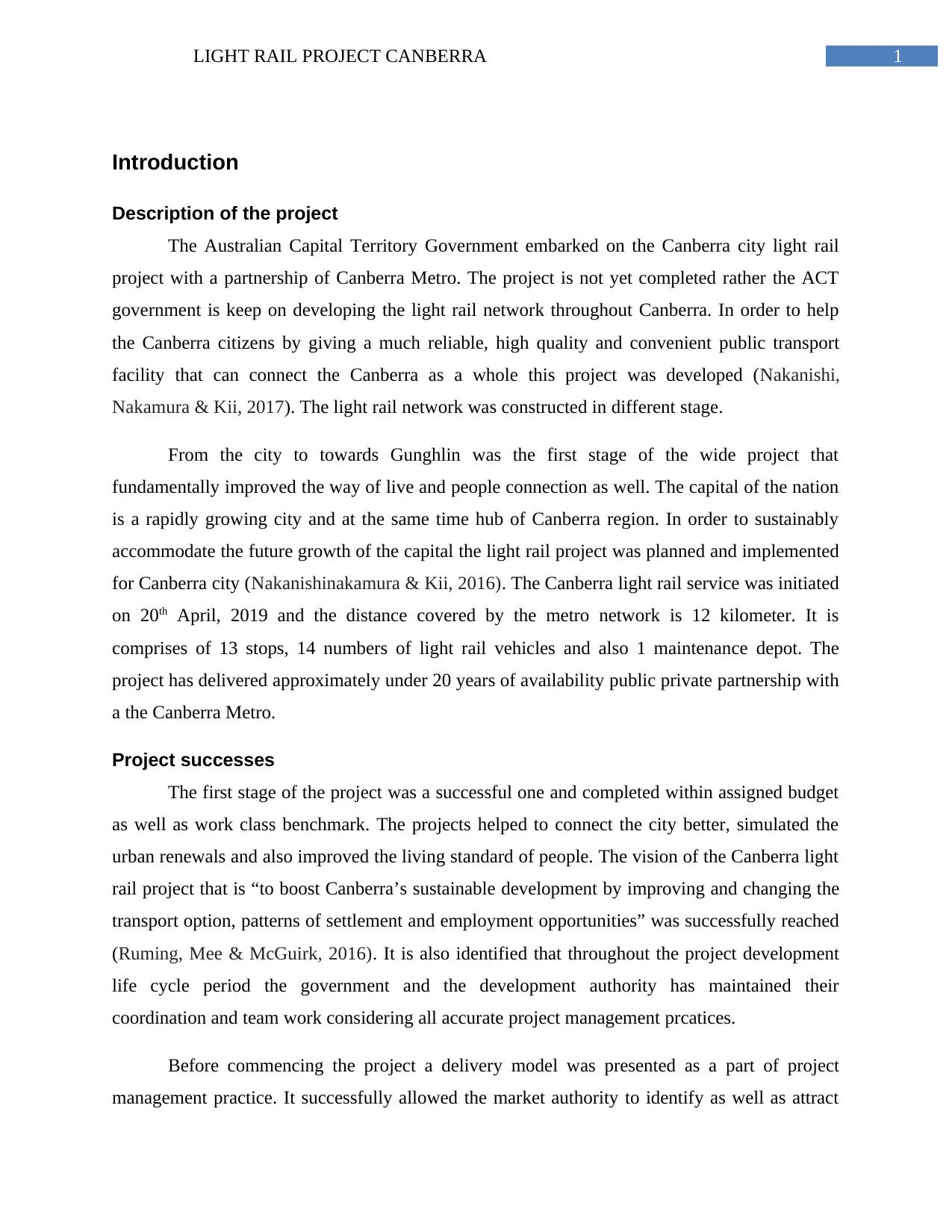
1LIGHT RAIL PROJECT CANBERRA
Introduction
Description of the project
The Australian Capital Territory Government embarked on the Canberra city light rail
project with a partnership of Canberra Metro. The project is not yet completed rather the ACT
government is keep on developing the light rail network throughout Canberra. In order to help
the Canberra citizens by giving a much reliable, high quality and convenient public transport
facility that can connect the Canberra as a whole this project was developed (Nakanishi,
Nakamura & Kii, 2017). The light rail network was constructed in different stage.
From the city to towards Gunghlin was the first stage of the wide project that
fundamentally improved the way of live and people connection as well. The capital of the nation
is a rapidly growing city and at the same time hub of Canberra region. In order to sustainably
accommodate the future growth of the capital the light rail project was planned and implemented
for Canberra city (Nakanishinakamura & Kii, 2016). The Canberra light rail service was initiated
on 20th April, 2019 and the distance covered by the metro network is 12 kilometer. It is
comprises of 13 stops, 14 numbers of light rail vehicles and also 1 maintenance depot. The
project has delivered approximately under 20 years of availability public private partnership with
a the Canberra Metro.
Project successes
The first stage of the project was a successful one and completed within assigned budget
as well as work class benchmark. The projects helped to connect the city better, simulated the
urban renewals and also improved the living standard of people. The vision of the Canberra light
rail project that is “to boost Canberra’s sustainable development by improving and changing the
transport option, patterns of settlement and employment opportunities” was successfully reached
(Ruming, Mee & McGuirk, 2016). It is also identified that throughout the project development
life cycle period the government and the development authority has maintained their
coordination and team work considering all accurate project management prcatices.
Before commencing the project a delivery model was presented as a part of project
management practice. It successfully allowed the market authority to identify as well as attract
Introduction
Description of the project
The Australian Capital Territory Government embarked on the Canberra city light rail
project with a partnership of Canberra Metro. The project is not yet completed rather the ACT
government is keep on developing the light rail network throughout Canberra. In order to help
the Canberra citizens by giving a much reliable, high quality and convenient public transport
facility that can connect the Canberra as a whole this project was developed (Nakanishi,
Nakamura & Kii, 2017). The light rail network was constructed in different stage.
From the city to towards Gunghlin was the first stage of the wide project that
fundamentally improved the way of live and people connection as well. The capital of the nation
is a rapidly growing city and at the same time hub of Canberra region. In order to sustainably
accommodate the future growth of the capital the light rail project was planned and implemented
for Canberra city (Nakanishinakamura & Kii, 2016). The Canberra light rail service was initiated
on 20th April, 2019 and the distance covered by the metro network is 12 kilometer. It is
comprises of 13 stops, 14 numbers of light rail vehicles and also 1 maintenance depot. The
project has delivered approximately under 20 years of availability public private partnership with
a the Canberra Metro.
Project successes
The first stage of the project was a successful one and completed within assigned budget
as well as work class benchmark. The projects helped to connect the city better, simulated the
urban renewals and also improved the living standard of people. The vision of the Canberra light
rail project that is “to boost Canberra’s sustainable development by improving and changing the
transport option, patterns of settlement and employment opportunities” was successfully reached
(Ruming, Mee & McGuirk, 2016). It is also identified that throughout the project development
life cycle period the government and the development authority has maintained their
coordination and team work considering all accurate project management prcatices.
Before commencing the project a delivery model was presented as a part of project
management practice. It successfully allowed the market authority to identify as well as attract
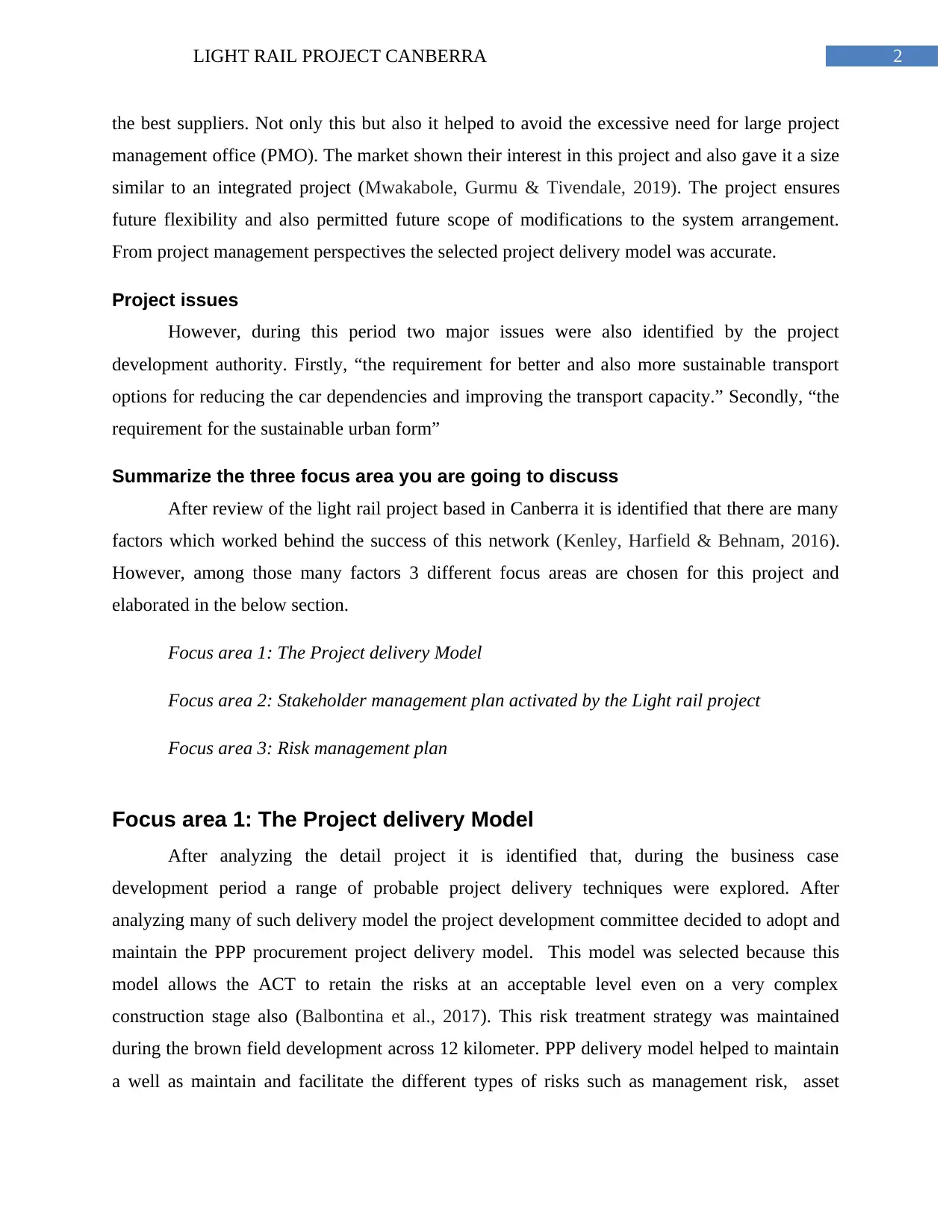
2LIGHT RAIL PROJECT CANBERRA
the best suppliers. Not only this but also it helped to avoid the excessive need for large project
management office (PMO). The market shown their interest in this project and also gave it a size
similar to an integrated project (Mwakabole, Gurmu & Tivendale, 2019). The project ensures
future flexibility and also permitted future scope of modifications to the system arrangement.
From project management perspectives the selected project delivery model was accurate.
Project issues
However, during this period two major issues were also identified by the project
development authority. Firstly, “the requirement for better and also more sustainable transport
options for reducing the car dependencies and improving the transport capacity.” Secondly, “the
requirement for the sustainable urban form”
Summarize the three focus area you are going to discuss
After review of the light rail project based in Canberra it is identified that there are many
factors which worked behind the success of this network (Kenley, Harfield & Behnam, 2016).
However, among those many factors 3 different focus areas are chosen for this project and
elaborated in the below section.
Focus area 1: The Project delivery Model
Focus area 2: Stakeholder management plan activated by the Light rail project
Focus area 3: Risk management plan
Focus area 1: The Project delivery Model
After analyzing the detail project it is identified that, during the business case
development period a range of probable project delivery techniques were explored. After
analyzing many of such delivery model the project development committee decided to adopt and
maintain the PPP procurement project delivery model. This model was selected because this
model allows the ACT to retain the risks at an acceptable level even on a very complex
construction stage also (Balbontina et al., 2017). This risk treatment strategy was maintained
during the brown field development across 12 kilometer. PPP delivery model helped to maintain
a well as maintain and facilitate the different types of risks such as management risk, asset
the best suppliers. Not only this but also it helped to avoid the excessive need for large project
management office (PMO). The market shown their interest in this project and also gave it a size
similar to an integrated project (Mwakabole, Gurmu & Tivendale, 2019). The project ensures
future flexibility and also permitted future scope of modifications to the system arrangement.
From project management perspectives the selected project delivery model was accurate.
Project issues
However, during this period two major issues were also identified by the project
development authority. Firstly, “the requirement for better and also more sustainable transport
options for reducing the car dependencies and improving the transport capacity.” Secondly, “the
requirement for the sustainable urban form”
Summarize the three focus area you are going to discuss
After review of the light rail project based in Canberra it is identified that there are many
factors which worked behind the success of this network (Kenley, Harfield & Behnam, 2016).
However, among those many factors 3 different focus areas are chosen for this project and
elaborated in the below section.
Focus area 1: The Project delivery Model
Focus area 2: Stakeholder management plan activated by the Light rail project
Focus area 3: Risk management plan
Focus area 1: The Project delivery Model
After analyzing the detail project it is identified that, during the business case
development period a range of probable project delivery techniques were explored. After
analyzing many of such delivery model the project development committee decided to adopt and
maintain the PPP procurement project delivery model. This model was selected because this
model allows the ACT to retain the risks at an acceptable level even on a very complex
construction stage also (Balbontina et al., 2017). This risk treatment strategy was maintained
during the brown field development across 12 kilometer. PPP delivery model helped to maintain
a well as maintain and facilitate the different types of risks such as management risk, asset
⊘ This is a preview!⊘
Do you want full access?
Subscribe today to unlock all pages.

Trusted by 1+ million students worldwide
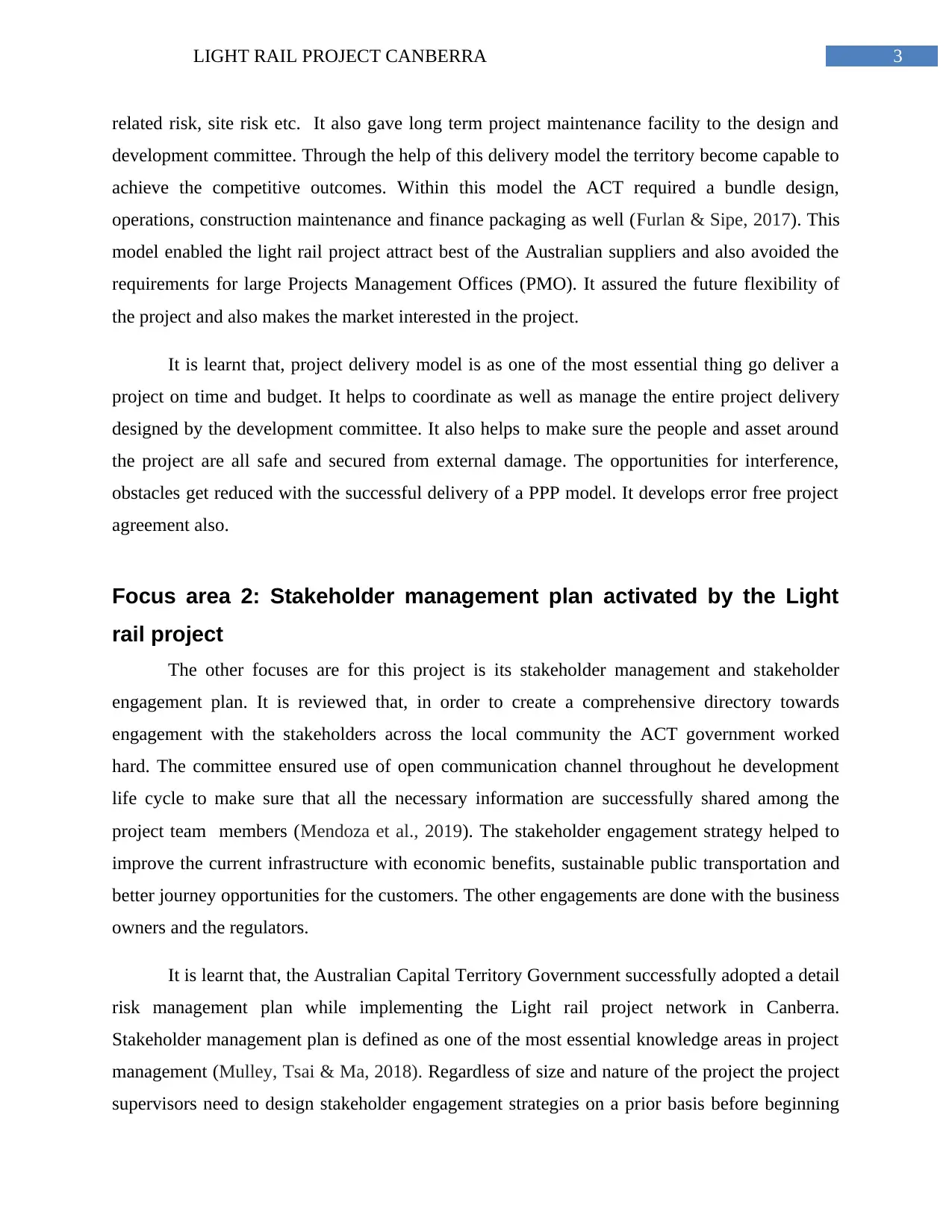
3LIGHT RAIL PROJECT CANBERRA
related risk, site risk etc. It also gave long term project maintenance facility to the design and
development committee. Through the help of this delivery model the territory become capable to
achieve the competitive outcomes. Within this model the ACT required a bundle design,
operations, construction maintenance and finance packaging as well (Furlan & Sipe, 2017). This
model enabled the light rail project attract best of the Australian suppliers and also avoided the
requirements for large Projects Management Offices (PMO). It assured the future flexibility of
the project and also makes the market interested in the project.
It is learnt that, project delivery model is as one of the most essential thing go deliver a
project on time and budget. It helps to coordinate as well as manage the entire project delivery
designed by the development committee. It also helps to make sure the people and asset around
the project are all safe and secured from external damage. The opportunities for interference,
obstacles get reduced with the successful delivery of a PPP model. It develops error free project
agreement also.
Focus area 2: Stakeholder management plan activated by the Light
rail project
The other focuses are for this project is its stakeholder management and stakeholder
engagement plan. It is reviewed that, in order to create a comprehensive directory towards
engagement with the stakeholders across the local community the ACT government worked
hard. The committee ensured use of open communication channel throughout he development
life cycle to make sure that all the necessary information are successfully shared among the
project team members (Mendoza et al., 2019). The stakeholder engagement strategy helped to
improve the current infrastructure with economic benefits, sustainable public transportation and
better journey opportunities for the customers. The other engagements are done with the business
owners and the regulators.
It is learnt that, the Australian Capital Territory Government successfully adopted a detail
risk management plan while implementing the Light rail project network in Canberra.
Stakeholder management plan is defined as one of the most essential knowledge areas in project
management (Mulley, Tsai & Ma, 2018). Regardless of size and nature of the project the project
supervisors need to design stakeholder engagement strategies on a prior basis before beginning
related risk, site risk etc. It also gave long term project maintenance facility to the design and
development committee. Through the help of this delivery model the territory become capable to
achieve the competitive outcomes. Within this model the ACT required a bundle design,
operations, construction maintenance and finance packaging as well (Furlan & Sipe, 2017). This
model enabled the light rail project attract best of the Australian suppliers and also avoided the
requirements for large Projects Management Offices (PMO). It assured the future flexibility of
the project and also makes the market interested in the project.
It is learnt that, project delivery model is as one of the most essential thing go deliver a
project on time and budget. It helps to coordinate as well as manage the entire project delivery
designed by the development committee. It also helps to make sure the people and asset around
the project are all safe and secured from external damage. The opportunities for interference,
obstacles get reduced with the successful delivery of a PPP model. It develops error free project
agreement also.
Focus area 2: Stakeholder management plan activated by the Light
rail project
The other focuses are for this project is its stakeholder management and stakeholder
engagement plan. It is reviewed that, in order to create a comprehensive directory towards
engagement with the stakeholders across the local community the ACT government worked
hard. The committee ensured use of open communication channel throughout he development
life cycle to make sure that all the necessary information are successfully shared among the
project team members (Mendoza et al., 2019). The stakeholder engagement strategy helped to
improve the current infrastructure with economic benefits, sustainable public transportation and
better journey opportunities for the customers. The other engagements are done with the business
owners and the regulators.
It is learnt that, the Australian Capital Territory Government successfully adopted a detail
risk management plan while implementing the Light rail project network in Canberra.
Stakeholder management plan is defined as one of the most essential knowledge areas in project
management (Mulley, Tsai & Ma, 2018). Regardless of size and nature of the project the project
supervisors need to design stakeholder engagement strategies on a prior basis before beginning
Paraphrase This Document
Need a fresh take? Get an instant paraphrase of this document with our AI Paraphraser
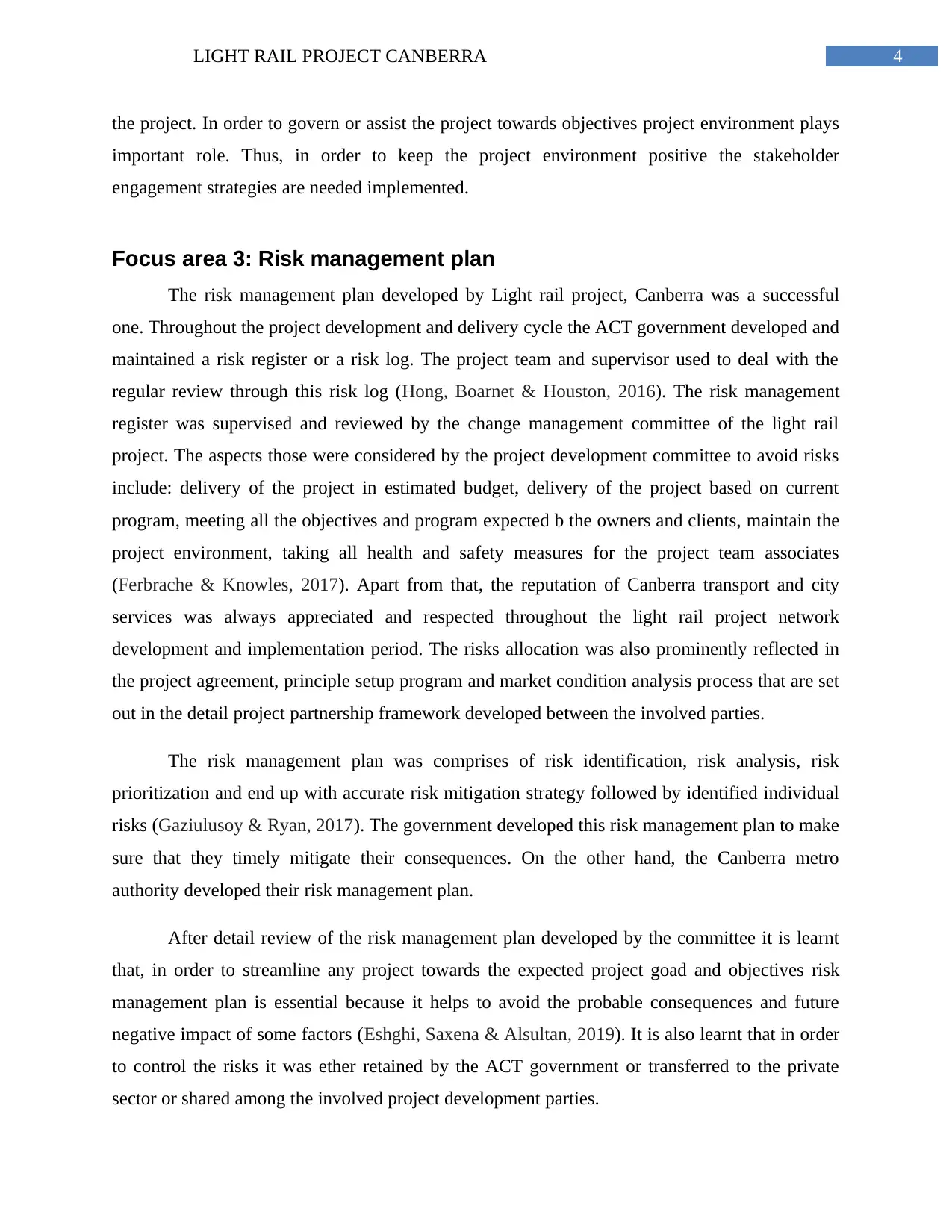
4LIGHT RAIL PROJECT CANBERRA
the project. In order to govern or assist the project towards objectives project environment plays
important role. Thus, in order to keep the project environment positive the stakeholder
engagement strategies are needed implemented.
Focus area 3: Risk management plan
The risk management plan developed by Light rail project, Canberra was a successful
one. Throughout the project development and delivery cycle the ACT government developed and
maintained a risk register or a risk log. The project team and supervisor used to deal with the
regular review through this risk log (Hong, Boarnet & Houston, 2016). The risk management
register was supervised and reviewed by the change management committee of the light rail
project. The aspects those were considered by the project development committee to avoid risks
include: delivery of the project in estimated budget, delivery of the project based on current
program, meeting all the objectives and program expected b the owners and clients, maintain the
project environment, taking all health and safety measures for the project team associates
(Ferbrache & Knowles, 2017). Apart from that, the reputation of Canberra transport and city
services was always appreciated and respected throughout the light rail project network
development and implementation period. The risks allocation was also prominently reflected in
the project agreement, principle setup program and market condition analysis process that are set
out in the detail project partnership framework developed between the involved parties.
The risk management plan was comprises of risk identification, risk analysis, risk
prioritization and end up with accurate risk mitigation strategy followed by identified individual
risks (Gaziulusoy & Ryan, 2017). The government developed this risk management plan to make
sure that they timely mitigate their consequences. On the other hand, the Canberra metro
authority developed their risk management plan.
After detail review of the risk management plan developed by the committee it is learnt
that, in order to streamline any project towards the expected project goad and objectives risk
management plan is essential because it helps to avoid the probable consequences and future
negative impact of some factors (Eshghi, Saxena & Alsultan, 2019). It is also learnt that in order
to control the risks it was ether retained by the ACT government or transferred to the private
sector or shared among the involved project development parties.
the project. In order to govern or assist the project towards objectives project environment plays
important role. Thus, in order to keep the project environment positive the stakeholder
engagement strategies are needed implemented.
Focus area 3: Risk management plan
The risk management plan developed by Light rail project, Canberra was a successful
one. Throughout the project development and delivery cycle the ACT government developed and
maintained a risk register or a risk log. The project team and supervisor used to deal with the
regular review through this risk log (Hong, Boarnet & Houston, 2016). The risk management
register was supervised and reviewed by the change management committee of the light rail
project. The aspects those were considered by the project development committee to avoid risks
include: delivery of the project in estimated budget, delivery of the project based on current
program, meeting all the objectives and program expected b the owners and clients, maintain the
project environment, taking all health and safety measures for the project team associates
(Ferbrache & Knowles, 2017). Apart from that, the reputation of Canberra transport and city
services was always appreciated and respected throughout the light rail project network
development and implementation period. The risks allocation was also prominently reflected in
the project agreement, principle setup program and market condition analysis process that are set
out in the detail project partnership framework developed between the involved parties.
The risk management plan was comprises of risk identification, risk analysis, risk
prioritization and end up with accurate risk mitigation strategy followed by identified individual
risks (Gaziulusoy & Ryan, 2017). The government developed this risk management plan to make
sure that they timely mitigate their consequences. On the other hand, the Canberra metro
authority developed their risk management plan.
After detail review of the risk management plan developed by the committee it is learnt
that, in order to streamline any project towards the expected project goad and objectives risk
management plan is essential because it helps to avoid the probable consequences and future
negative impact of some factors (Eshghi, Saxena & Alsultan, 2019). It is also learnt that in order
to control the risks it was ether retained by the ACT government or transferred to the private
sector or shared among the involved project development parties.
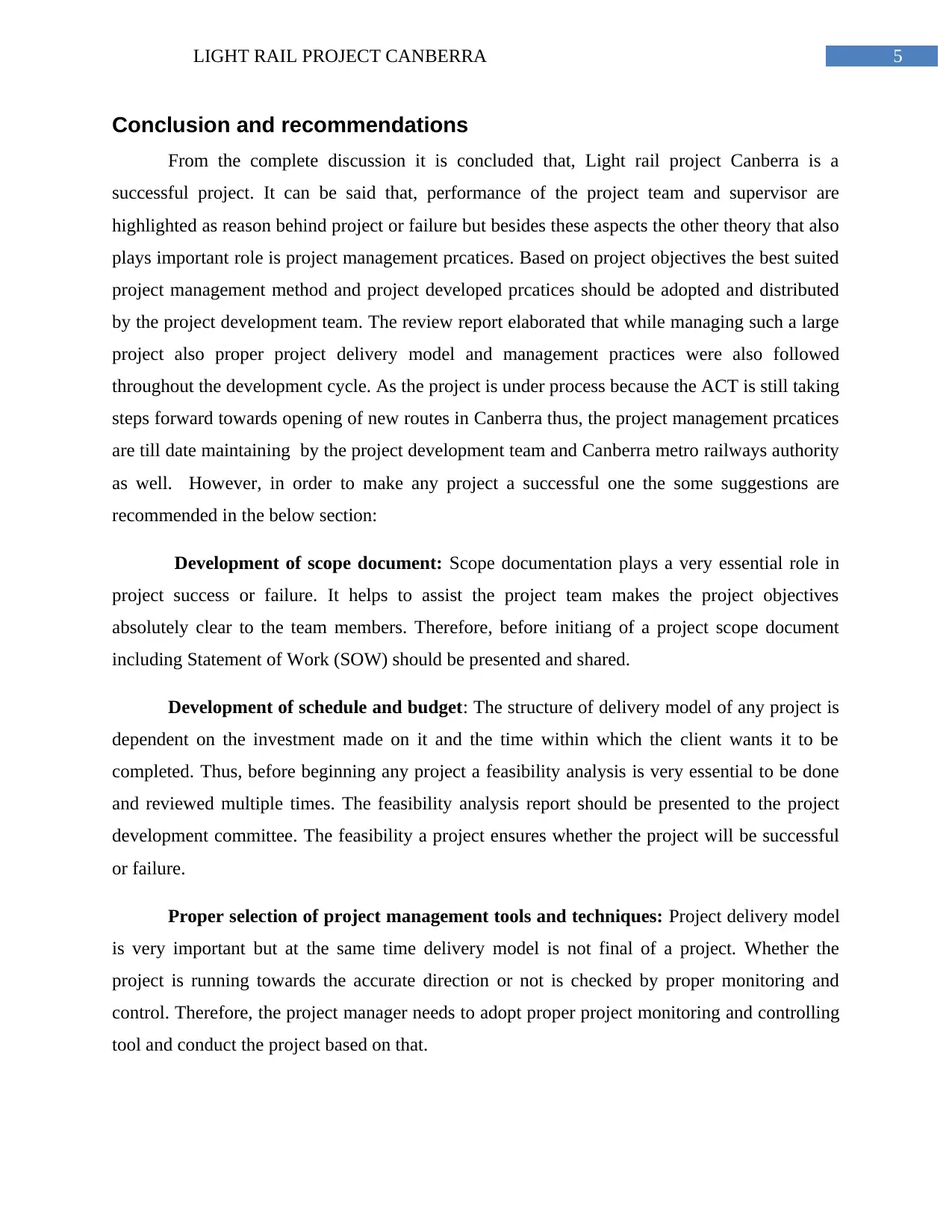
5LIGHT RAIL PROJECT CANBERRA
Conclusion and recommendations
From the complete discussion it is concluded that, Light rail project Canberra is a
successful project. It can be said that, performance of the project team and supervisor are
highlighted as reason behind project or failure but besides these aspects the other theory that also
plays important role is project management prcatices. Based on project objectives the best suited
project management method and project developed prcatices should be adopted and distributed
by the project development team. The review report elaborated that while managing such a large
project also proper project delivery model and management practices were also followed
throughout the development cycle. As the project is under process because the ACT is still taking
steps forward towards opening of new routes in Canberra thus, the project management prcatices
are till date maintaining by the project development team and Canberra metro railways authority
as well. However, in order to make any project a successful one the some suggestions are
recommended in the below section:
Development of scope document: Scope documentation plays a very essential role in
project success or failure. It helps to assist the project team makes the project objectives
absolutely clear to the team members. Therefore, before initiang of a project scope document
including Statement of Work (SOW) should be presented and shared.
Development of schedule and budget: The structure of delivery model of any project is
dependent on the investment made on it and the time within which the client wants it to be
completed. Thus, before beginning any project a feasibility analysis is very essential to be done
and reviewed multiple times. The feasibility analysis report should be presented to the project
development committee. The feasibility a project ensures whether the project will be successful
or failure.
Proper selection of project management tools and techniques: Project delivery model
is very important but at the same time delivery model is not final of a project. Whether the
project is running towards the accurate direction or not is checked by proper monitoring and
control. Therefore, the project manager needs to adopt proper project monitoring and controlling
tool and conduct the project based on that.
Conclusion and recommendations
From the complete discussion it is concluded that, Light rail project Canberra is a
successful project. It can be said that, performance of the project team and supervisor are
highlighted as reason behind project or failure but besides these aspects the other theory that also
plays important role is project management prcatices. Based on project objectives the best suited
project management method and project developed prcatices should be adopted and distributed
by the project development team. The review report elaborated that while managing such a large
project also proper project delivery model and management practices were also followed
throughout the development cycle. As the project is under process because the ACT is still taking
steps forward towards opening of new routes in Canberra thus, the project management prcatices
are till date maintaining by the project development team and Canberra metro railways authority
as well. However, in order to make any project a successful one the some suggestions are
recommended in the below section:
Development of scope document: Scope documentation plays a very essential role in
project success or failure. It helps to assist the project team makes the project objectives
absolutely clear to the team members. Therefore, before initiang of a project scope document
including Statement of Work (SOW) should be presented and shared.
Development of schedule and budget: The structure of delivery model of any project is
dependent on the investment made on it and the time within which the client wants it to be
completed. Thus, before beginning any project a feasibility analysis is very essential to be done
and reviewed multiple times. The feasibility analysis report should be presented to the project
development committee. The feasibility a project ensures whether the project will be successful
or failure.
Proper selection of project management tools and techniques: Project delivery model
is very important but at the same time delivery model is not final of a project. Whether the
project is running towards the accurate direction or not is checked by proper monitoring and
control. Therefore, the project manager needs to adopt proper project monitoring and controlling
tool and conduct the project based on that.
⊘ This is a preview!⊘
Do you want full access?
Subscribe today to unlock all pages.

Trusted by 1+ million students worldwide
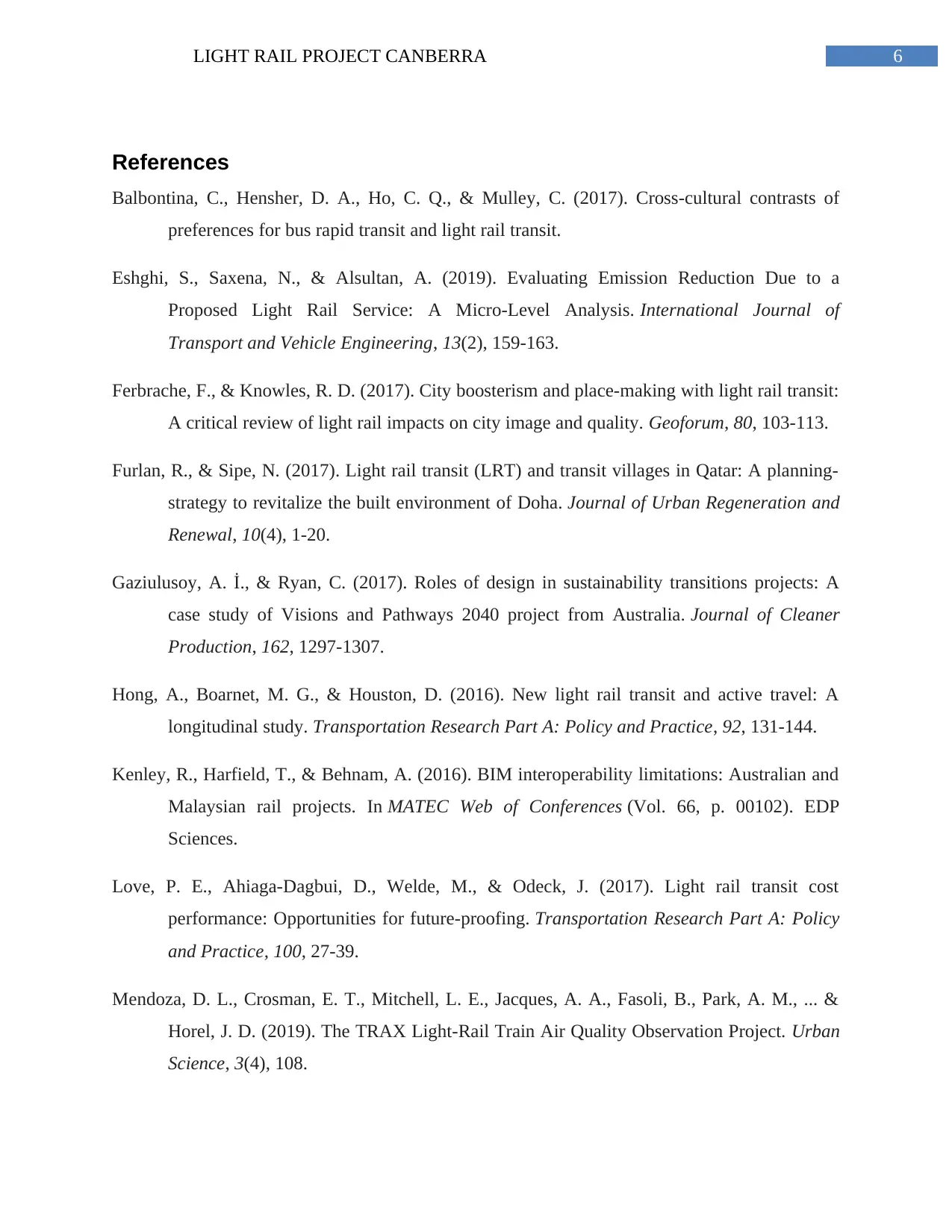
6LIGHT RAIL PROJECT CANBERRA
References
Balbontina, C., Hensher, D. A., Ho, C. Q., & Mulley, C. (2017). Cross-cultural contrasts of
preferences for bus rapid transit and light rail transit.
Eshghi, S., Saxena, N., & Alsultan, A. (2019). Evaluating Emission Reduction Due to a
Proposed Light Rail Service: A Micro-Level Analysis. International Journal of
Transport and Vehicle Engineering, 13(2), 159-163.
Ferbrache, F., & Knowles, R. D. (2017). City boosterism and place-making with light rail transit:
A critical review of light rail impacts on city image and quality. Geoforum, 80, 103-113.
Furlan, R., & Sipe, N. (2017). Light rail transit (LRT) and transit villages in Qatar: A planning-
strategy to revitalize the built environment of Doha. Journal of Urban Regeneration and
Renewal, 10(4), 1-20.
Gaziulusoy, A. İ., & Ryan, C. (2017). Roles of design in sustainability transitions projects: A
case study of Visions and Pathways 2040 project from Australia. Journal of Cleaner
Production, 162, 1297-1307.
Hong, A., Boarnet, M. G., & Houston, D. (2016). New light rail transit and active travel: A
longitudinal study. Transportation Research Part A: Policy and Practice, 92, 131-144.
Kenley, R., Harfield, T., & Behnam, A. (2016). BIM interoperability limitations: Australian and
Malaysian rail projects. In MATEC Web of Conferences (Vol. 66, p. 00102). EDP
Sciences.
Love, P. E., Ahiaga-Dagbui, D., Welde, M., & Odeck, J. (2017). Light rail transit cost
performance: Opportunities for future-proofing. Transportation Research Part A: Policy
and Practice, 100, 27-39.
Mendoza, D. L., Crosman, E. T., Mitchell, L. E., Jacques, A. A., Fasoli, B., Park, A. M., ... &
Horel, J. D. (2019). The TRAX Light-Rail Train Air Quality Observation Project. Urban
Science, 3(4), 108.
References
Balbontina, C., Hensher, D. A., Ho, C. Q., & Mulley, C. (2017). Cross-cultural contrasts of
preferences for bus rapid transit and light rail transit.
Eshghi, S., Saxena, N., & Alsultan, A. (2019). Evaluating Emission Reduction Due to a
Proposed Light Rail Service: A Micro-Level Analysis. International Journal of
Transport and Vehicle Engineering, 13(2), 159-163.
Ferbrache, F., & Knowles, R. D. (2017). City boosterism and place-making with light rail transit:
A critical review of light rail impacts on city image and quality. Geoforum, 80, 103-113.
Furlan, R., & Sipe, N. (2017). Light rail transit (LRT) and transit villages in Qatar: A planning-
strategy to revitalize the built environment of Doha. Journal of Urban Regeneration and
Renewal, 10(4), 1-20.
Gaziulusoy, A. İ., & Ryan, C. (2017). Roles of design in sustainability transitions projects: A
case study of Visions and Pathways 2040 project from Australia. Journal of Cleaner
Production, 162, 1297-1307.
Hong, A., Boarnet, M. G., & Houston, D. (2016). New light rail transit and active travel: A
longitudinal study. Transportation Research Part A: Policy and Practice, 92, 131-144.
Kenley, R., Harfield, T., & Behnam, A. (2016). BIM interoperability limitations: Australian and
Malaysian rail projects. In MATEC Web of Conferences (Vol. 66, p. 00102). EDP
Sciences.
Love, P. E., Ahiaga-Dagbui, D., Welde, M., & Odeck, J. (2017). Light rail transit cost
performance: Opportunities for future-proofing. Transportation Research Part A: Policy
and Practice, 100, 27-39.
Mendoza, D. L., Crosman, E. T., Mitchell, L. E., Jacques, A. A., Fasoli, B., Park, A. M., ... &
Horel, J. D. (2019). The TRAX Light-Rail Train Air Quality Observation Project. Urban
Science, 3(4), 108.
Paraphrase This Document
Need a fresh take? Get an instant paraphrase of this document with our AI Paraphraser
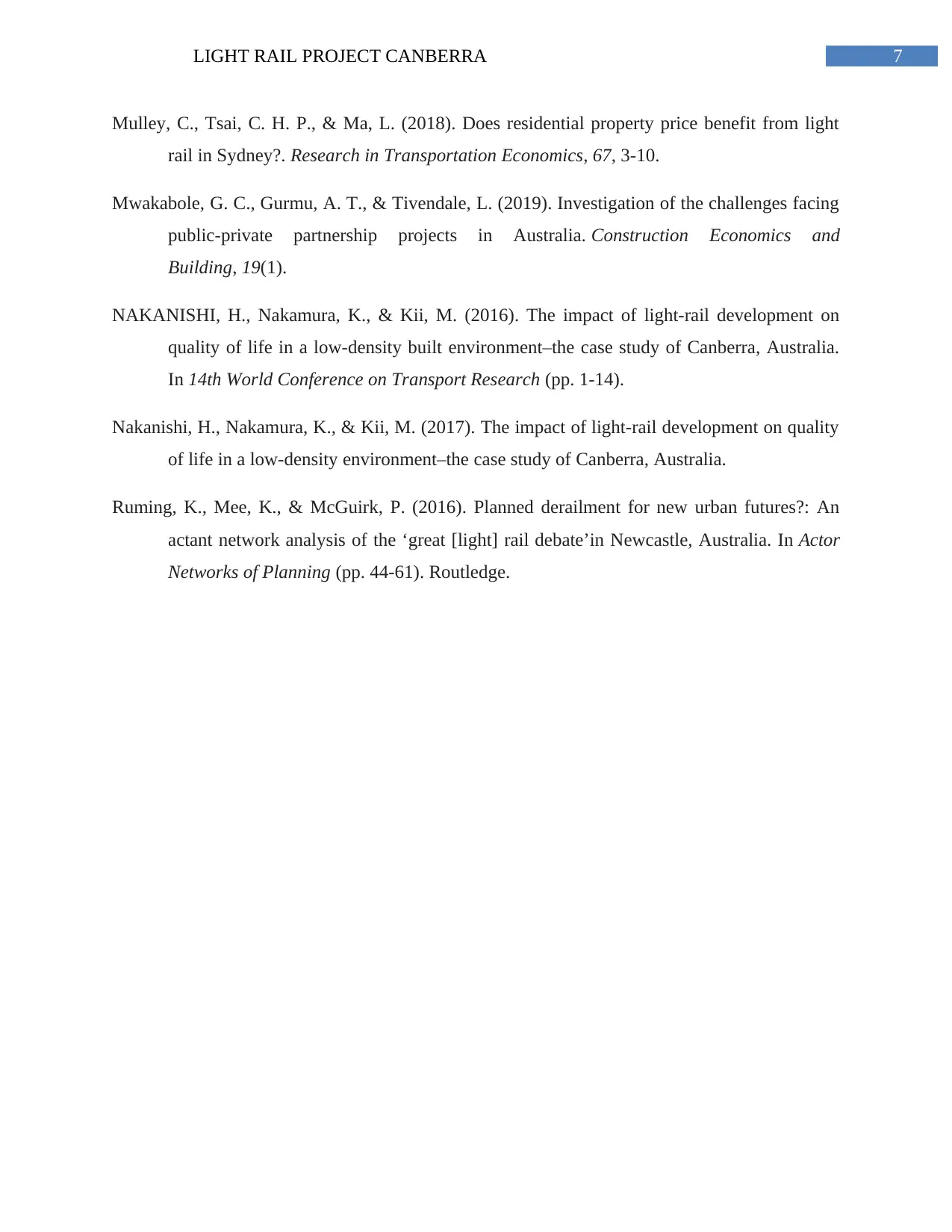
7LIGHT RAIL PROJECT CANBERRA
Mulley, C., Tsai, C. H. P., & Ma, L. (2018). Does residential property price benefit from light
rail in Sydney?. Research in Transportation Economics, 67, 3-10.
Mwakabole, G. C., Gurmu, A. T., & Tivendale, L. (2019). Investigation of the challenges facing
public-private partnership projects in Australia. Construction Economics and
Building, 19(1).
NAKANISHI, H., Nakamura, K., & Kii, M. (2016). The impact of light-rail development on
quality of life in a low-density built environment–the case study of Canberra, Australia.
In 14th World Conference on Transport Research (pp. 1-14).
Nakanishi, H., Nakamura, K., & Kii, M. (2017). The impact of light-rail development on quality
of life in a low-density environment–the case study of Canberra, Australia.
Ruming, K., Mee, K., & McGuirk, P. (2016). Planned derailment for new urban futures?: An
actant network analysis of the ‘great [light] rail debate’in Newcastle, Australia. In Actor
Networks of Planning (pp. 44-61). Routledge.
Mulley, C., Tsai, C. H. P., & Ma, L. (2018). Does residential property price benefit from light
rail in Sydney?. Research in Transportation Economics, 67, 3-10.
Mwakabole, G. C., Gurmu, A. T., & Tivendale, L. (2019). Investigation of the challenges facing
public-private partnership projects in Australia. Construction Economics and
Building, 19(1).
NAKANISHI, H., Nakamura, K., & Kii, M. (2016). The impact of light-rail development on
quality of life in a low-density built environment–the case study of Canberra, Australia.
In 14th World Conference on Transport Research (pp. 1-14).
Nakanishi, H., Nakamura, K., & Kii, M. (2017). The impact of light-rail development on quality
of life in a low-density environment–the case study of Canberra, Australia.
Ruming, K., Mee, K., & McGuirk, P. (2016). Planned derailment for new urban futures?: An
actant network analysis of the ‘great [light] rail debate’in Newcastle, Australia. In Actor
Networks of Planning (pp. 44-61). Routledge.
1 out of 8
Related Documents
Your All-in-One AI-Powered Toolkit for Academic Success.
+13062052269
info@desklib.com
Available 24*7 on WhatsApp / Email
![[object Object]](/_next/static/media/star-bottom.7253800d.svg)
Unlock your academic potential
Copyright © 2020–2025 A2Z Services. All Rights Reserved. Developed and managed by ZUCOL.





